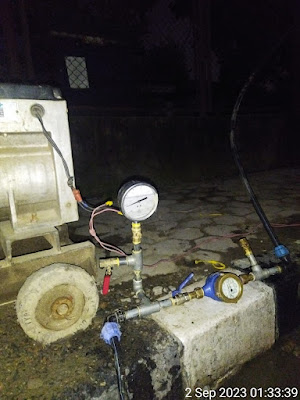Hydrostatic testing of pipe line
Procedure of test
• Filling: Before starting filling, all end points of pipe network must be plugged including house connection points, fire hydrant and other appurtenances if any. Slowly fill the pipeline to limit the flow to low velocities that prevent surges and air entrapment. Also, air valves at high points should be opened to allow air to escape as the water level increases inside the pipeline. Temporary valves can be installed.
• Test pressure: Up to 1.5 times the working pressure and is taken at the lowest point in elevation along the pipe’s test section. However, care should be taken that pressure at any point in the network should not exceed the pressure rating of pipe materials.
high care should be taken if pressure test is done on DI pipe section. Pipe line section under test should be restrained against movement before pressure is applied. Required thrust block and sufficient support blocks are used on free end.
• Maintain test pressure for 2 hours;• Pass if pressure stays within 5% of the reduced pressure or measured water pressure should not vary by more than 5 psi during the duration of the test. all visible leakage should be repaired and pressure test repeated until satisfactory results are obtained.• Similarly, Leak test is done to establish that the section of main being tested, including all joints, fittings and other appurtenances will not leak or that leakage is within acceptable limits.
• Leakage is defined as the quantity of water that must be supplied into the main in order to maintain the water pressure within 5 psi of the specified test pressure after the pipe has been filled with water and air expelled.
Formula for permissible/allowable leakage
L= (SD✔P)/80344.7 Liters per hour, where S- length of pipe tested, m
D- nominal diameter of the pipe, mm
P- avg. test pressure during test, Kg/sq.cm.
• Test records: Records shall be made of each piping system during the testing, including:
Time and date of test
Identification of piping system tested
Test fluid (normally water)
Pipe size and length of tested section
Test pressure ( at lower and higher point)
Pressure recording chart in every 1/2 hour
Test duration
Certification of results by examiner
Sample of test report
Typical pressure test arrangement in injection point








0 Comments